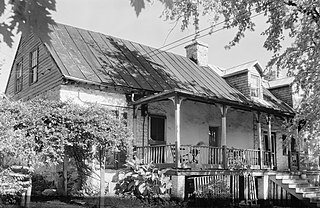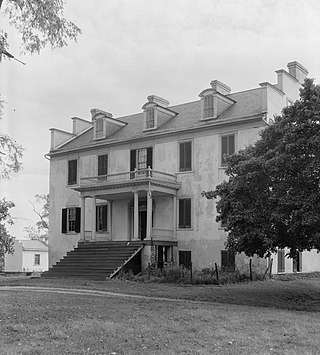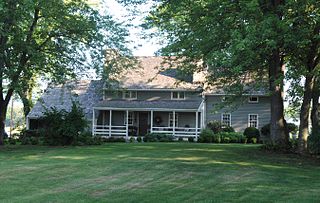
Jefferson County is located in the Shenandoah Valley in the Eastern Panhandle of West Virginia. It is the easternmost county of the U.S. state of West Virginia. As of the 2020 census, the population was 57,701. Its county seat is Charles Town. The county was founded in 1801, and today is part of the Washington metropolitan area.

The Grave Creek Mound in the Ohio River Valley in West Virginia is one of the largest conical-type burial mounds in the United States, now standing 62 feet (19 m) high and 240 feet (73 m) in diameter. The builders of the site, members of the Adena culture, moved more than 60,000 tons of dirt to create it about 250–150 BC.

White House Farm, also known as White House Tavern and the Dr. John McCormick House, listed in the National Register of Historic Places, is located in Jefferson County, West Virginia, near the small town of Summit Point, about six miles from Charles Town, West Virginia. The farm consists of a ca. 1740 farmhouse, a stone barn, a springhouse of about the same age, a wooden curing shed, and 60+ acres of pasture and woods. The farm is one of the oldest in the county and has a rich history.
Leetown is an unincorporated community in Jefferson County in the U.S. state of West Virginia. It lies along West Virginia Secondary Route 1 at its junction with Leetown Pike.

The Peter Burr House was built between 1751 and 1755 near present-day Shenandoah Junction, West Virginia, making it one of the oldest houses in West Virginia. Burr, whose first cousin was Aaron Burr, was one of the first settlers in the area. It is the oldest surviving post-and-beam-construction house in West Virginia. The 9.5-acre (3.8 ha) property was acquired from Burr family descendants in the 1990s and has been under restoration by Jefferson County Historic Landmarks Commission.

Harewood is one of several houses in the vicinity of Charles Town, West Virginia built for members of the Washington family.

Woodbury or Woodberry, is a historic mansion located near Leetown, Jefferson County, West Virginia. It was built in 1834-1835 for the jurist and Congressman Henry St. George Tucker, Sr. (1780–1848). Tucker lived at Woodbury from its construction until 1844.

The Hermitage near Charles Town, West Virginia is historic property which includes several buildings, as well as non-contributing tennis courts and a pool. The oldest structure is a small stone cottage dating to circa 1734, making it one of the oldest buildings in West Virginia. It resembles Prato Rio in nearby Leetown, West Virginia and may date to this property's first owner, Daniel Barnett, who was a partner in the Burr Iron Works circa 1740, the first of its kind in the state. A stone privy is also believed to be the oldest structure of its kind in the state.
Hopewell, also known as Hopewell Mills and Hopewell Farm, was established around 1765 by William Little, Sr., who built grain and saw mills near the Shenandoah River. In 1827, William Little, Jr. sold the property to James Hite and Jacob Newcomer. Hite named the property "Hopewell", identifying the mill with a place in Leetown also named Hopewell, where there was a Quaker meeting house. Hite's descendant, Thomas Hite Willis, operated and expanded the mill, adding a woolen mill. The woolen mill operated until the 1920s providing uniforms for the Army.

Gap View Farm, near Charles Town, West Virginia, is a historic farm complex built in 1774. The farm was placed on the National Register of Historic Places on January 9, 1997.

Traveller's Rest, also known as the General Horatio Gates Home, is an historic plantation house located on Bowers Road near Kearneysville, Jefferson County, West Virginia. Built in 1773 and enlarged a few years later, it was the home of Continental Army General Horatio Gates from 1773 until 1790. The house is very little altered from that period, and was designated a National Historic Landmark in 1972. The house is located on private property, and is not normally open to the public.

McMillan Hall is a building on the campus of Washington & Jefferson College in Washington, Pennsylvania, United States. Built in 1793, it is the only surviving building from Washington Academy. It is the eighth-oldest academic building in the United States that is still in use for its original academic purpose and is the oldest surviving college building west of the Allegheny Mountains.

The Thomas Brown House in Inwood, West Virginia, was built about 1741 as a log cabin for Thomas Brown, a Quaker farmer. Brown was one of the first to grow fruit in an area where orchardry would become a major agricultural industry. The house is the oldest known dwelling in Berkeley County.

The Col. James Graham House is a historic log cabin located on West Virginia Route 3 in Lowell, West Virginia. It was built in 1770 as a home for Col. James Graham, the first settler of Lowell, and his family. It was later the site of an Indian attack on the Graham family in 1777. The house was added to the National Register of Historic Places on March 16, 1976. The Graham House is the oldest multi-story log cabin in West Virginia. It is currently operating as a museum.

Mirador is a historic home located near Greenwood, Albemarle County, Virginia. It was built in 1842 for James M. Bowen (1793–1880), and is a two-story, brick structure on a raised basement in the Federal style. It has a deck-on-hip roof capped by a Chinese Chippendale railing. The front facade features a portico with paired Tuscan order columns. The house was renovated in the 1920s by noted New York architect William Adams Delano (1874–1960), who transformed the house into a Georgian Revival mansion.
Rohrbaugh Cabin — also known as Allegheny Cabin — is a historic log cabin located on the eastern slope of North Fork Mountain near Petersburg, Grant County, West Virginia, USA.

The Timberline Cabin in Rocky Mountain National Park, Colorado, USA was built in 1925 to house workers on the Fall River Road. The National Park Service rustic style cabin was designed by the National Park Service's Landscape Engineering Division under the direction of Thomas Chalmers Vint. The cabin was later used as a patrol cabin and as a caretaker's residence.

Hopewell Friends Meeting House is an 18th-century Quaker meeting house located the northern Frederick County, Virginia one mile west of the community of Clear Brook at 604 Hopewell Road. Clear Brook, VA 22624. This community was the home of Thomas William "Tom" Fox (1951–2006), a Quaker peace activist, affiliated with Christian Peacemaker Teams (CPT) murdered in 2006 in Iraq.

Abram's Delight is a historic home located in Winchester, Virginia. Built in 1754, it is the oldest house in the city. It was owned by the Hollingsworth family for almost 200 years and is typical of the Shenandoah Valley architecture of the Scotch-Irish settlers. The property was added to the Virginia Landmarks Register (VLR) in 1972 and the National Register of Historic Places (NRHP) in 1973. Abram's Delight currently serves as a historic house museum.

The Elk Lake Guard Station is a United States Forest Service cabin located in the Deschutes National Forest southwest of Bend, Oregon. The guard station was built in 1929 on the north shore of Elk Lake. It was used as a home base for Forest Service personnel who protected forest resources, maintained facilities, and aided summer visitors in the Cascade Lakes area of Central Oregon. After decades of use, the cabin was renovated in the late 1990s. Today, the historic guard station serves as a Forest Service visitor information center along the Cascade Lakes Scenic Byway. The Elk Lake Guard Station is listed on the National Register of Historic Places.




















